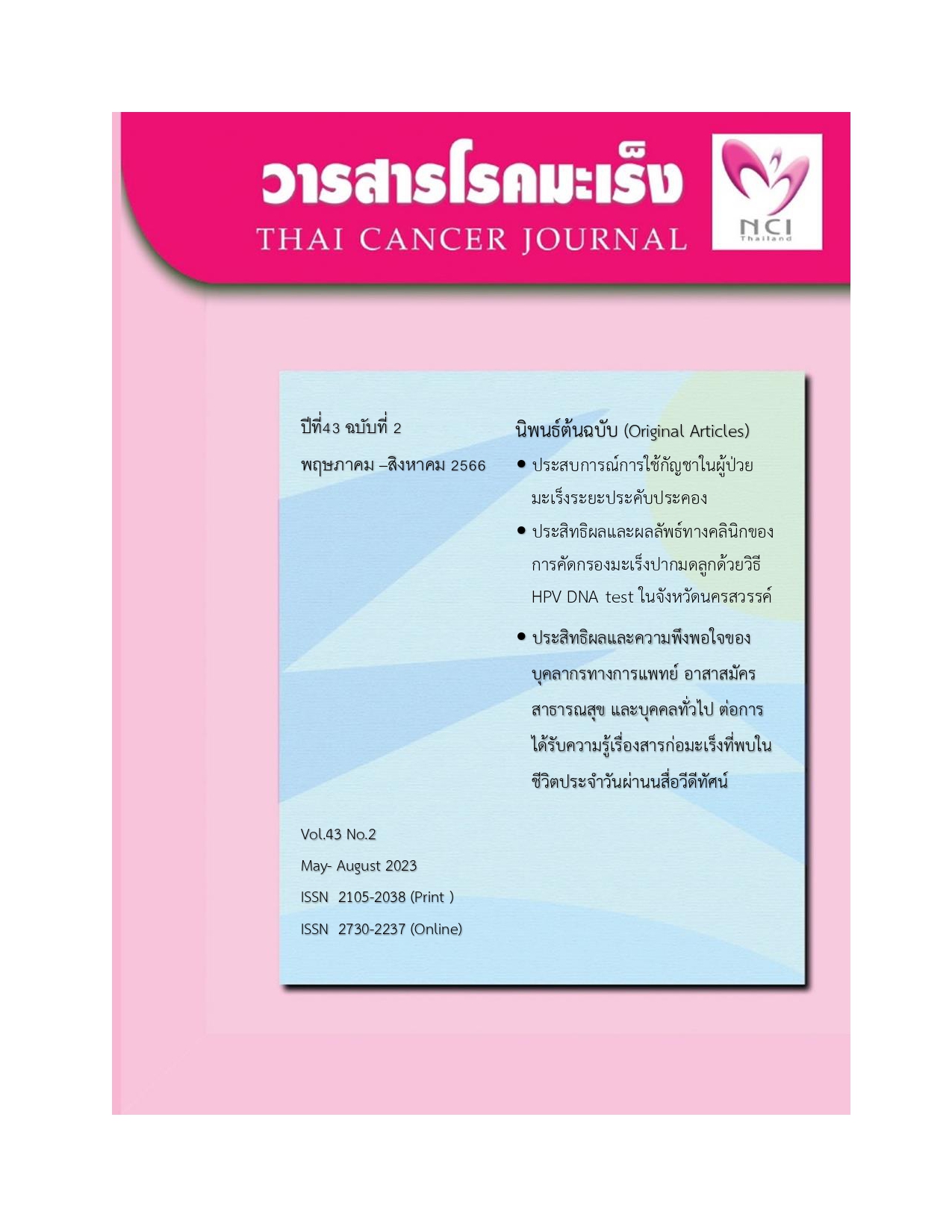Experience of cannabis in patients with palliative cancer
Keywords:
experience of cannabis, medical cannabis, patients with palliative cancerAbstract
Pain is the most common clinical symptom that 90 percent of cancer patients experience. It is the primary factor that diminishes patients' quality of life. Patients with cancer are palliatively treated with opioids. Currently, the Thai government has enacted legislation to allow cannabis for medical use, but it has been found that most patients are receiving drugs from outside the public health system. Therefore, information on how cannabis can be used is limited. The study explored the experience of patients with palliative cancer who used cannabis. The study design was qualitative research. The data were collected using in-depth interviews of 20 patients with palliative cancer. The data were analyzed by thematic analysis. The study found that the patients aged between 27-74 years, and the mean age was 59.55 years, the onset of cancer was 8 months to 9 years, and the mean duration of illness was 2.31 years. The experience of cannabis use was divided into five main issues: 1.deciding to use cannabis as a last resort, seeing on the news that cannabis cures cancer, hearing/telling stories from others, studying information in textbooks and journals, and fear of dying, want to live without suffering, and want to live without worry 2. The forms of cannabis used were cannabis extract, cannabis oil, fresh cannabis and dried cannabis. 3. Sources of cannabis included hospitals, self-cultivation, self-bought and deposition by siblings/grandchildren /friends. 4..Methods for using cannabis included dropping under the tongue, eating, boiling, and smoking 5.Clinical outcomes of cannabis included improved sleep, eating more, relaxation, good mood, less pain, less anxiety, less tiredness, more energy, better health, better skin, and a fresher look. In conclusion, the experience of cannabis use in patients with palliative cancer was consistent in the positive direction, and patients want to continue using cannabis for cancer treatment. It is recommended that cancer patients be granted permission to grow cannabis for self-treatment due to its ease of access, affordability, safety, minimal side effects, and potential for improved health outcomes.
References
World Health Organization (WHO)[Internet]. Cancer Today. [cited 2023 June 06]. Available from: https://bit.ly/3J5qOvh
World Health Organization (WHO) [Internet]. Cancer Today. [cited 2023 June 06]. Available from: https://bit.ly/45TOHj3
World Health Organization (WHO) [Internet]. Cancer Tomorrow. [cited 2023 June 06]. Available from: https://gco.iarc.fr/tomorrow/en/dataviz/isotype
World Health Organization (WHO) [Internet]. Cancer Tomorrow. [cited 2023 June 06]. Availablefrom:https://gco.iarc.fr/tomorrow/en/dataviz/isotype?types=1&single_unit=5000
World Health Organization (WHO) [Internet]. Cancer Today. [cited 2023 June 06]. Available from: https://bit.ly/43Iper0
World Health Organization (WHO) [Internet]. Cancer Today. [cited 2023 June 06]. Available from: https://bit.ly/43x1LZY
ศราวุธ นนทะศิลา, สุพจน์ คำสะอาด . อัตรารอดชีพของผู้ป่วยมะเร็งช่องปากหลังการวินิจฉัยที่ได้รับการรักษาในโรงพยาบาลบุรีรัมย์ จังหวัดบุรีรัมย์. ศรีนครินทร์เวชสาร 2563;35(6):753-59
Appendino G, Chianese G, Taglialatela-Scafati O. Cannabinoids: occurrence and medicinal chemistry. Current Medicinal Chemistry 2011;18(7):1085–99.
สำนักงานคณะกรรมการอาหารและยา. สรุปจำนวนผู้มารับบริการในคลินิกกัญชาทางการแพทย์ [อินเทอร์เน็ต]. กระทรวงสาธารณสุข; 2564 [เข้าถึงเมื่อ 18 มกราคม 2566]. เข้าถึงได้จาก: http://toiminta2.fda.moph.go.th/Reports/powerbi/MRJN/report_ recive?rs: embed=true
สำนักงานคณะกรรมการอาหารและยา. รายงานประสิทธิภาพประสิทธิผลและความปลอดภัยจากการใช้กัญชา [อินเทอร์เน็ต]. กระทรวงสาธารณสุข; 2564 [เข้าถึงเมื่อ 19 มกราคม 2566]. เข้าถึงได้จาก:http://toiminta2.fda.moph.go.th/Reports/powerbi/MRJN/hvpc_bi?rs:embed=true&APP=GUEST
Phansila N, Wongkongdech R, Sittiwech C [Internet]. Survival Rate of Cholangiocarcinoma, Hepatocellular Patients Received Cannabis Treatment. Research Square; 2021. [cited 2023 June 10]. Available from: https://assets.researchsquare.com/files/rs-1030279/v1/81a19f09-840d-41c0-86a6-342acff19245.pdf?c=1644210851
ณัฐิกา วรรณแก้ว. ทัศนคติต่อการรักษาด้วยน้ำมันกัญชาของผู้ป่วยมะเร็งในคลินิกกัญชาทางการแพทย์โรงพยาบาลสมเด็จพระยุพราชเดชอุดม จังหวัดอุบลราชธานี.
วารสารการแพทย์แผนไทยและการแพทย์ทางเลือก 2565;20(2):405-14.
เบญจวรรณ พูนธนานิวัฒน์กุล, เจมส์ พึ่งผล, สุวภัทร บุญเรือน, วันเพ็ญ ยอดคง, ณัฐพล ชมภูธวัช, พรชัย แช่มตา. ปัจจัยที่มีผลต่อการตัดสินใจเลือกใช้กัญชาทางการแพทย์ของผู้รับบริการด้าน การแพทย์แผนไทยในสถานพยาบาลคัดสรร. วารสารวิจัยและนวัตกรรมทางสุขภาพ 2565;5(1):48-61.
กิตติวัฒน์ กันทะ, สมบัติ กาศเมฆ และนิภาพร ใจบาน. ผลการพัฒนาคลินิกดูแลผู้ป่วยแบบประคับประคองและกัญชาทางการแพทย์ โรงพยาบาลจุน จังหวัดพะเยา. วารสารวิชาการป้องกัน ควบคุมโรค สคร.2 พิษณุโลก 2564;8(3):41-56.
ระศักดิ์ ศรีเจริญ. รายงานผู้ป่วย:ประสบการณ์การรักษาผู้ป่วย ด้วยนํ้ามันกัญชา 1.7% THC เจ้าพระยา อภัยภูเบศรในโรงพยาบาลพระนั่งเกล้า 1 ม.ค.2563-31 ธ.ค.2563. วารสารการแพทย์และสาธารณสุขเขต 4 2564;11(2):93-100.
พงศธร ทองกระสี และดุษฎี ศรีธาตุ. ประสิทธิผลของชาที่มีส่วนผสมของกัญชาต่อการนอนไม่หลับ.วารสารวิทยาศาสตร์สุขภาพแห่งประเทศไทย 2565;5(1):25-32.
อรรถสิทธิ ศรีสุบัติ, สมชาย ธนะสิทธิชัย, อรุณี ไทยะกุล, สุรีพร คนละเอียด, วรนุตร อรุณรัตนโชติ, ธนะรัตน์ อิมสุวรรณศรี, ชนัญญู มงคล, วนศรี ไพศาลตันติวงศ์, วารุณี เศวตประวิชกุล. ผลของการใช้ยา สกัดกัญชาชนิด THC เด่นในผู้ป่วยมะเร็งระยะลุกลาม. วารสารกรมการแพทย์ 2563;45(4):208-14.
กัญญาภัค ศิลารักษ์. ประสิทธิผลของน้ำมันกัญชาสูตร อ.เดชา ต่อคุณภาพการนอนหลับและคุณภาพ ชีวิตในผู้ป่วยนอก ณ คลินิกหางกระรอก โรงพยาบาลพระอาจารย์ฝั้น อาจาโร. วารสารศูนย์อนามัยที่ 9 2565;16(3):1097-108.
ศศิพงค์ ทิพย์รัชดาพร, จริยา สีทา, พิพัฒพงศ์ ป้อมไชยา, สมฤทัย บุญญาวรรณ, กัญญาภัค ศิลารักษ์.ประโยชน์และความปลอดภัยของตำรับยาศุขไสยาศน์ในผู้ป่วยที่มีภาวะนอนไม่หลับ. วารสารการแพทย์แผนไทยและการแพทย์ทางเลือก 2564;19(2):317-30.
อุษณีย์ เอกสุวีรพงษ์, ช่อผกา นาคมิตร. ความรู้และทัศนคติต่อกัญชาทางการแพทย์ของประชาชน ตำบลเขาถ่าน อำเภอท่าฉาง จังหวัดสุราษฎร์ธานี. วารสารวิทยาศาสตร์สุขภาพแห่งประเทศไทย 2565;4(2):77-86.
ณิตชาธร ภาโนมัย, ธนันรักษ์ วัชราธร, ธีรศักดิ์ พาจันทร์, ชาตรีเจริญ ชีวะกุล. ความรอบรู้ด้านสุขภาพในการใช้กัญชาทางการแพทย์ของผู้ป่วยมะเร็งในภาคตะวันออกเฉียงเหนือของประเทศไทย. วารสารวิจัยและพัฒนาด้านสุขภาพ สำนักงานสาธารณสุขจังหวัดนครราชสีมา 2565;8(1):49-67.
พีระ อารีรัตน์. ความรู้และความเชื่อด้านสุขภาพเกี่ยวกับการใช้กัญชาทางการแพทย์ของผู้รับบริการใน โรงพยาบาลจังหวัดพระนครศรีอยุธยา. วารสารวิจัยและพัฒนาระบบสุขภาพ 2564;14(2):1-12.
รัตติยา แดนดงยิ่ง, กรแก้ว จันทภาษา. พฤติกรรมและเหตุผลการใช้กัญชาของประชาชน: กรณีศึกษา ในจังหวัดกาฬสินธุ์. วารสารเภสัชกรรมไทย 2565;14(3):594-603.
ธนเมศวร์ แท่นคำ. ผลทางคลินิกและความปลอดภัยของกัญชาทางการแพทย์ในผู้ป่วยมะเร็ง [วิทยานิพนธ์ปริญญาปรัชญาดุษฎีบัณฑิต]. ขอนแก่น: มหาวิทยาลัยขอนแก่น; 2566.
Thanamet Thaenkham. The pain management experience of patients with palliative cancer using cannabis in the northeastern part of Thailand. International Journal of Engineering and Science 2023;13(7):34-40
Downloads
Published
Issue
Section
License
Copyright (c) 2023 Thailand's National Cancer Institute Foundation

This work is licensed under a Creative Commons Attribution-NonCommercial-NoDerivatives 4.0 International License.
บทความทีตีพิมพ์ในวารสารโรคมะเร็งนี้ถือว่าเป็นลิขสิทธิ์ของมูลนิธิสถาบันมะเร็งแห่งชาติ และผลงานวิชาการหรือวิจัยของคณะผู้เขียน ไม่ใช่ความคิดเห็นของบรรณาธิการหรือผู้จัดทํา







